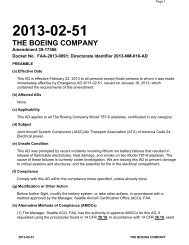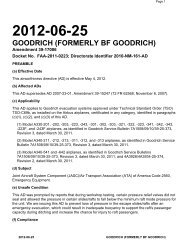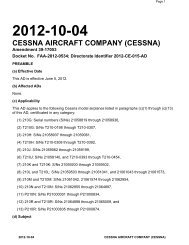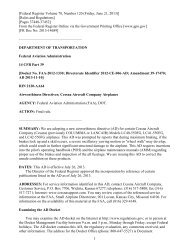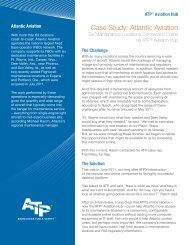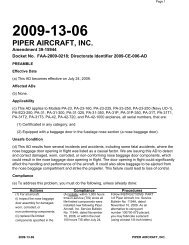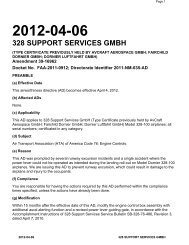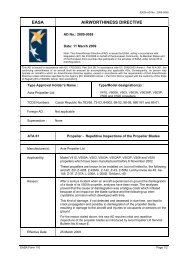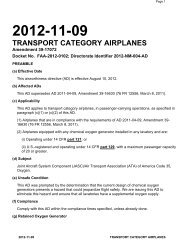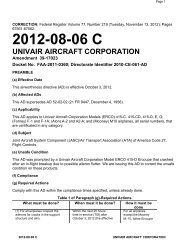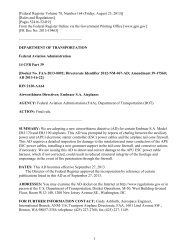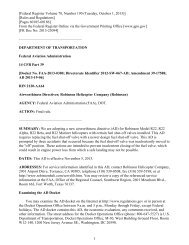AD 2013-06-51 - Civil Aviation Safety Authority
AD 2013-06-51 - Civil Aviation Safety Authority
AD 2013-06-51 - Civil Aviation Safety Authority
Create successful ePaper yourself
Turn your PDF publications into a flip-book with our unique Google optimized e-Paper software.
Examining the <strong>AD</strong> DocketYou may examine the <strong>AD</strong> docket on the Internet at http://www.regulations.gov or in person atthe Docket Operations Office between 9 a.m. and 5 p.m., Monday through Friday, except Federalholidays. The <strong>AD</strong> docket contains this <strong>AD</strong>, the economic evaluation, any comments received, andother information. The street address for the Docket Operations Office (telephone 800-647-5527) isin the <strong>AD</strong>DRESSES section. Comments will be available in the <strong>AD</strong> docket shortly after receipt.For service information identified in this <strong>AD</strong>, contact: Goodrich Corporation, Sensors &Integrated Systems (SIS-CA), Brea, CA 92821; telephone (714) 984-1461;http://www.goodrich.com/Goodrich. You may review the referenced service information at the FAA,Office of the Regional Counsel, Southwest Region, 2601 Meacham Blvd., Room 663, Fort Worth,Texas 76137.FOR FURTHER INFORMATION CONTACT: Matt Wilbanks, <strong>Aviation</strong> <strong>Safety</strong> Engineer,Regulations and Policy Group, Rotorcraft Directorate, FAA, 2601 Meacham Blvd., Fort Worth,Texas 76137; telephone (817) 222-<strong>51</strong>10; email matt.wilbanks@faa.gov.SUPPLEMENTARY INFORMATION:Comments InvitedThis <strong>AD</strong> is a final rule that involves requirements affecting flight safety, and we did not provideyou with notice and an opportunity to provide your comments prior to it becoming effective.However, we invite you to participate in this rulemaking by submitting written comments, data, orviews. We also invite comments relating to the economic, environmental, energy, or federalismimpacts that resulted from adopting this <strong>AD</strong>. The most helpful comments reference a specific portionof the <strong>AD</strong>, explain the reason for any recommended change, and include supporting data. To ensurethe docket does not contain duplicate comments, commenters should send only one copy of writtencomments, or if comments are filed electronically, commenters should submit them only one time.We will file in the docket all comments that we receive, as well as a report summarizing eachsubstantive public contact with FAA personnel concerning this rulemaking during the commentperiod. We will consider all the comments we receive and may conduct additional rulemaking basedon those comments.DiscussionWe are issuing this <strong>AD</strong> to publish E<strong>AD</strong> No. <strong>2013</strong>-<strong>06</strong>-<strong>51</strong>, issued on March 25, <strong>2013</strong>, which wasfor helicopter models with certain part-numbered and serial-numbered Goodrich externally-mountedhoists. E<strong>AD</strong> No. <strong>2013</strong>-<strong>06</strong>-<strong>51</strong> was prompted by an incident that occurred during a maintenance checkof a rescue hoist that lost the ability to hold the load at maximum rated capacity, causing the test loadto strike the ground. A Eurocopter Deutschland GmbH (ECD) Model MBB-BK 117 C-2 helicopterpicked up a dummy load of 552 lbs. to conduct a ''maximum load cycle'' on the rescue hoist. Initially,the cable reeled out and stopped as commanded by the winch operator; however, the cable continuedto reel-out without further command by the winch operator, causing the dummy load to strike theground. Examination of the affected hoist determined that the overload clutch had failed. E<strong>AD</strong> No.<strong>2013</strong>-<strong>06</strong>-<strong>51</strong> requires performing a cable conditioning lift, performing a load inspection test, andrecording the results on the hoist component history card or equivalent record. The actions of E<strong>AD</strong>No. <strong>2013</strong>-<strong>06</strong>-<strong>51</strong> were intended to detect conditions that may result in failure of the hoist and injury topersons being lifted.E<strong>AD</strong> No. <strong>2013</strong>-<strong>06</strong>-<strong>51</strong> was prompted by <strong>AD</strong> No. <strong>2013</strong>-0<strong>06</strong>5-E, issued March 14, <strong>2013</strong> (<strong>2013</strong>-0<strong>06</strong>5-E), and superseded with <strong>AD</strong> No. <strong>2013</strong>-0077-E, issued March 22, <strong>2013</strong>, by the European<strong>Aviation</strong> <strong>Safety</strong> Agency (EASA), which is the Technical Agent for the Member States of the2
European Union. EASA issued <strong>AD</strong> <strong>2013</strong>-0<strong>06</strong>5-E to correct an unsafe condition for helicopters withcertain part-numbered and serial-numbered Goodrich hoists installed. EASA advised of the reportthat an ECD Model MBB-BK 117 C-2 helicopter experienced an incident of its rescue hoistcontaining a dummy load of 552 lbs. that reeled-out without command of the operator and impactedthe ground during a maintenance check flight. Examination of the affected hoist determined that theoverload clutch had failed. The overload clutch design is common to many Goodrich externallymountedrescue hoists installed on the applicable model helicopters. EASA further stated its <strong>AD</strong>action is considered an interim action and further <strong>AD</strong> action may follow.Since we issued E<strong>AD</strong> No. <strong>2013</strong>-<strong>06</strong>-<strong>51</strong>, EASA revised its <strong>AD</strong> with EASA <strong>AD</strong> No. <strong>2013</strong>-0077R1,dated March 27, <strong>2013</strong> (<strong>2013</strong>-0077R1). In issuing <strong>AD</strong> No. <strong>2013</strong>-0077R1, EASA changed the initialcompliance time, reduced the applicability of certain model helicopters for which no EASAapprovals of the hoist installation are known, and partially adopted FAA E<strong>AD</strong> No. <strong>2013</strong>-<strong>06</strong>-<strong>51</strong> forthose helicopter models for which the FAA is the State of Design <strong>Authority</strong>. EASA continues toconsider <strong>AD</strong> No. <strong>2013</strong>-0077R1 an interim action and further <strong>AD</strong> action may follow. You may viewEASA <strong>AD</strong> <strong>2013</strong>-0077R1 at http://www.regulations.gov by searching for and locating it in DocketNo. FAA-<strong>2013</strong>-0521.In publishing this <strong>AD</strong>, we are retaining the applicability and required actions of E<strong>AD</strong> No. <strong>2013</strong>-<strong>06</strong>-<strong>51</strong>. As we have determined that the MD Helicopters, Inc., Model MD900 helicopter is anothermodel helicopter on which an affected hoist may be installed, we are adding that model helicopter tothe applicability. This addition does not increase the economic burden on any operator nor does itincrease the scope of the <strong>AD</strong>.FAA's DeterminationThese helicopters have been approved by the aviation authorities of Canada, Italy, France, andGermany and are approved for operation in the United States. Pursuant to our bilateral agreementwith the European countries, EASA, their technical representative, has notified us of the unsafecondition described in the EASA <strong>AD</strong>. We are issuing this <strong>AD</strong> because we evaluated all knownrelevant information and determined the unsafe condition exists and is likely to exist or develop onother helicopters of these same type designs.Related Service InformationGoodrich issued Alert Service Bulletin No. 44301-10-15, dated March 8, <strong>2013</strong> (ASB), for certainexternally-mounted rescue hoists manufactured by Goodrich Sensors & Integrated Systems. The ASBspecifies inspecting and performing an operational check of the hoist. The ASB also specifiesrecording the performance in the hoist log and reporting the results of the test to UTC AerospaceSystems.<strong>AD</strong> RequirementsThis <strong>AD</strong> requires compliance with specified portions of the ASB to do the following before thenext flight involving a hoist operation:• Performing a cable conditioning lift;• Performing a load inspection test;• Deactivating or replacing any hoist that fails the load inspection test; and• Recording the results of the load inspection test on the hoist component history card orequivalent record.3
Differences Between This <strong>AD</strong> and the EASA <strong>AD</strong>The EASA <strong>AD</strong> applies to specific model helicopters. This <strong>AD</strong> applies to all helicopters withcertain Goodrich hoists installed that are type certificated in the U.S. This <strong>AD</strong> does not contain arequirement to report results to the manufacturer. The EASA <strong>AD</strong> requires complying with specifichelicopter manufacturer ASBs, and this <strong>AD</strong> requires complying with the Goodrich ASB forconducting the load inspection test.Interim ActionWe consider this <strong>AD</strong> to be an interim action. Investigation of the root cause of the clutch failureis ongoing. If final action is later identified, we might consider further rulemaking.Costs of ComplianceWe estimate that this <strong>AD</strong> will affect 1,378 helicopters of U.S. Registry. We estimate thatoperators may incur the following costs in order to comply with this <strong>AD</strong>. It will take about 1 workhourto perform the lift testing at an average labor rate of $85 per work-hour, for a cost per helicopterof $85 and a total cost to U.S. operators of $117,130. If necessary, replacing the hoist will take about0.5 work-hour and required parts will cost about $95,000, for a cost per helicopter of about $95,043.FAA's Justification and Determination of the Effective DateThe short compliance time involved is required because risk analysis of the previously describedunsafe condition indicates that failure of the hoist could result in serious injury or death if the hoist isbeing used for human cargo. Subsequently, the required actions must be performed before the nextflight involving a hoist operation.Since it was found that immediate corrective action was required, notice and opportunity forprior public comment before issuing this <strong>AD</strong> were impracticable and contrary to the public interestand good cause existed for making Emergency <strong>AD</strong> No. <strong>2013</strong>-<strong>06</strong>-<strong>51</strong> effective immediately on March25, <strong>2013</strong>, to all known U.S. owners and operators of the specified model helicopters. Theseconditions still exist and the <strong>AD</strong> is hereby published, with a minor change, in the Federal Register asan amendment to section 39.13 of the Federal <strong>Aviation</strong> Regulations (14 CFR 39.13) to make iteffective to all persons.<strong>Authority</strong> for This RulemakingTitle 49 of the United States Code specifies the FAA's authority to issue rules on aviation safety.Subtitle I, section 1<strong>06</strong>, describes the authority of the FAA Administrator. ''Subtitle VII: <strong>Aviation</strong>Programs,'' describes in more detail the scope of the Agency's authority.We are issuing this rulemaking under the authority described in ''Subtitle VII, Part A, Subpart III,Section 44701: General requirements.'' Under that section, Congress charges the FAA with promotingsafe flight of civil aircraft in air commerce by prescribing regulations for practices, methods, andprocedures the Administrator finds necessary for safety in air commerce. This regulation is within thescope of that authority because it addresses an unsafe condition that is likely to exist or develop onproducts identified in this rulemaking action.Regulatory FindingsWe determined that this <strong>AD</strong> will not have federalism implications under Executive Order 13132.This <strong>AD</strong> will not have a substantial direct effect on the States, on the relationship between the4
national Government and the States, or on the distribution of power and responsibilities among thevarious levels of government.For the reasons discussed, I certify that this <strong>AD</strong>:1. Is not a ''significant regulatory action'' under Executive Order 12866;2. Is not a ''significant rule'' under DOT Regulatory Policies and Procedures (44 FR 11034,February 26, 1979);3. Will not affect intrastate aviation in Alaska to the extent that it justifies making a regulatorydistinction; and4. Will not have a significant economic impact, positive or negative, on a substantial number ofsmall entities under the criteria of the Regulatory Flexibility Act.We prepared an economic evaluation of the estimated costs to comply with this <strong>AD</strong> and placed itin the <strong>AD</strong> docket.List of Subjects in 14 CFR Part 39Air transportation, Aircraft, <strong>Aviation</strong> safety, Incorporation by reference, <strong>Safety</strong>.Adoption of the AmendmentAccordingly, under the authority delegated to me by the Administrator, the FAA amends 14 CFRpart 39 as follows:PART 39–AIRWORTHINESS DIRECTIVES1. The authority citation for part 39 continues to read as follows:<strong>Authority</strong>: 49 U.S.C. 1<strong>06</strong>(g), 40113, 44701.§ 39.13 [Amended]2. The FAA amends § 39.13 by adding the following new airworthiness directive (<strong>AD</strong>):5
(2) Perform a load inspection test by following the Accomplishment Instructions, paragraphs2.B. through 2.I., of the ASB. Refer to the aircraft weight and balance limitations prior to performingthis test and use a balancing load if necessary to prevent helicopter rollover. Any alternate method ofcomplying with the load inspection test must first be approved in accordance with paragraph (g) ofthis <strong>AD</strong>.(3) If the hoist fails the load inspection test, deactivate or replace the hoist with an airworthyhoist.(4) Record the result of the load inspection test on the hoist component history card or equivalentrecord.(g) Alternative Methods of Compliance (AMOCs)(1) The Manager, <strong>Safety</strong> Management Group, FAA, may approve AMOCs for this <strong>AD</strong>. Sendyour proposal to: Matt Wilbanks, <strong>Aviation</strong> <strong>Safety</strong> Engineer, Regulations and Policy Group,Rotorcraft Directorate, FAA, 2601 Meacham Blvd., Fort Worth, Texas 76137; telephone (817) 222-<strong>51</strong>10; email matt.wilbanks@faa.gov.(2) For operations conducted under a 14 CFR part 119 operating certificate or under 14 CFR part91, subpart K, we suggest that you notify your principal inspector, or lacking a principal inspector,the manager of the local flight standards district office or certificate holding district office, beforeoperating any aircraft complying with this <strong>AD</strong> through an AMOC.(h) Additional InformationThe subject of this <strong>AD</strong> is addressed in European <strong>Aviation</strong> <strong>Safety</strong> Agency (EASA) <strong>AD</strong> No. <strong>2013</strong>-0077R1, dated March 27, <strong>2013</strong>. You may view the EASA <strong>AD</strong> at http://www.regulations.gov bysearching for and locating it in Docket No. FAA-<strong>2013</strong>-0521.(i) SubjectJoint Aircraft Service Component (JASC) Code: 2500, Equipment/Furnishings.(j) Material Incorporated by Reference(1) The Director of the Federal Register approved the incorporation by reference (IBR) of theservice information listed in this paragraph under 5 U.S.C. 552(a) and 1 CFR part <strong>51</strong>.(2) You must use this service information as applicable to do the actions required by this <strong>AD</strong>,unless the <strong>AD</strong> specifies otherwise.(i) Goodrich Alert Service Bulletin No. 44301-10-15, dated March 8, <strong>2013</strong>.(ii) Reserved.(3) For Goodrich Corporation's service information identified in this <strong>AD</strong>, contact GoodrichCorporation, Sensors & Integrated Systems (SIS-CA), Brea, CA 92821; telephone (714) 984-1461;http://www.goodrich.com/Goodrich.(4) You may view this service information at FAA, Office of the Regional Counsel, SouthwestRegion, 2601 Meacham Blvd., Room 663, Fort Worth, Texas 76137. For information on theavailability of this material at the FAA, call (817) 222-<strong>51</strong>10.(5) You may view this service information that is incorporated by reference at the NationalArchives and Records Administration (NARA). For information on the availability of this material atNARA, call (202) 741-6030, or go to: http://www.archives.gov/federal-register/cfr/ibr-locations.html.7
Issued in Fort Worth, Texas, on June 13, <strong>2013</strong>.Kim Smith,Directorate Manager, Rotorcraft Directorate,Aircraft Certification Service.8



